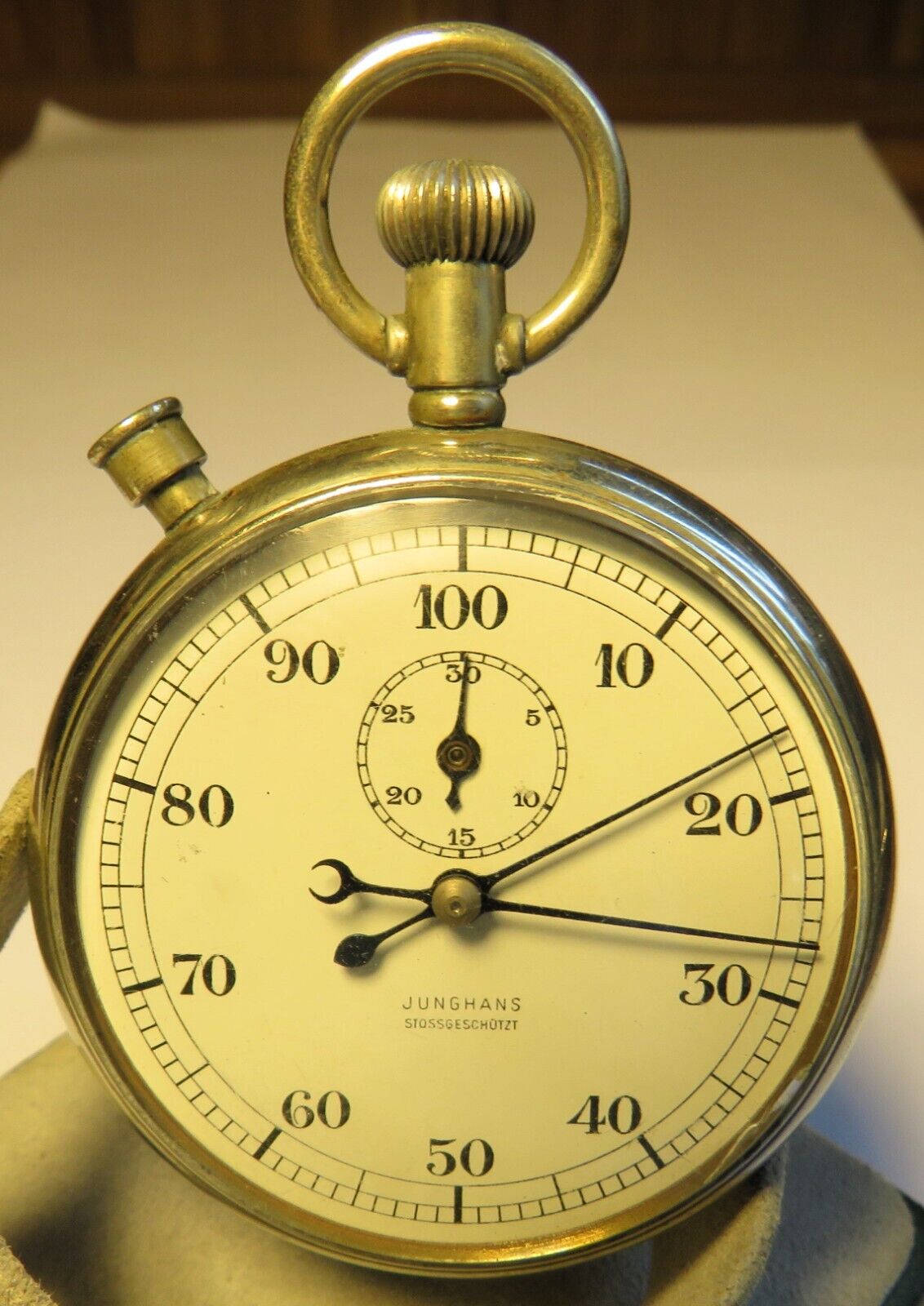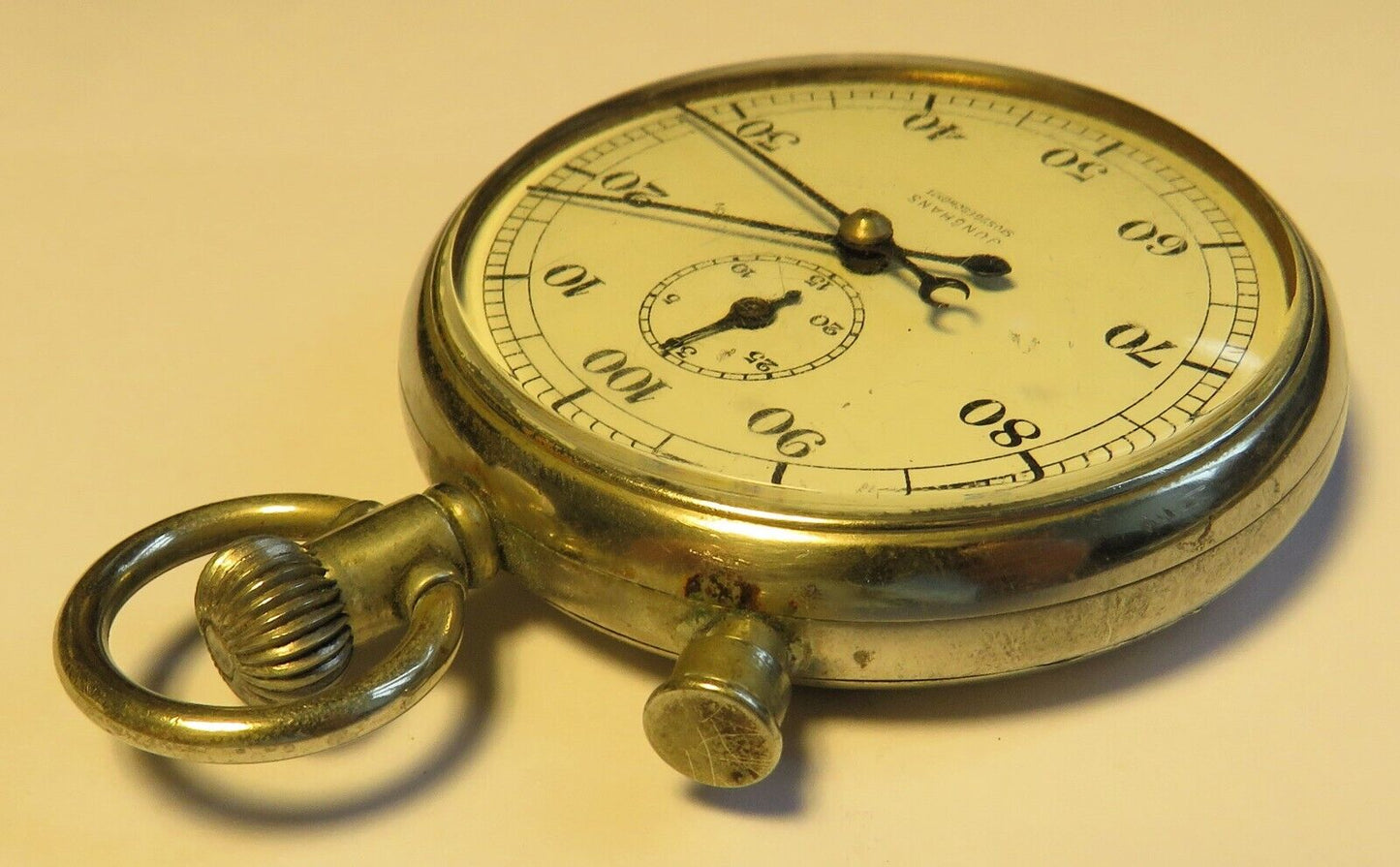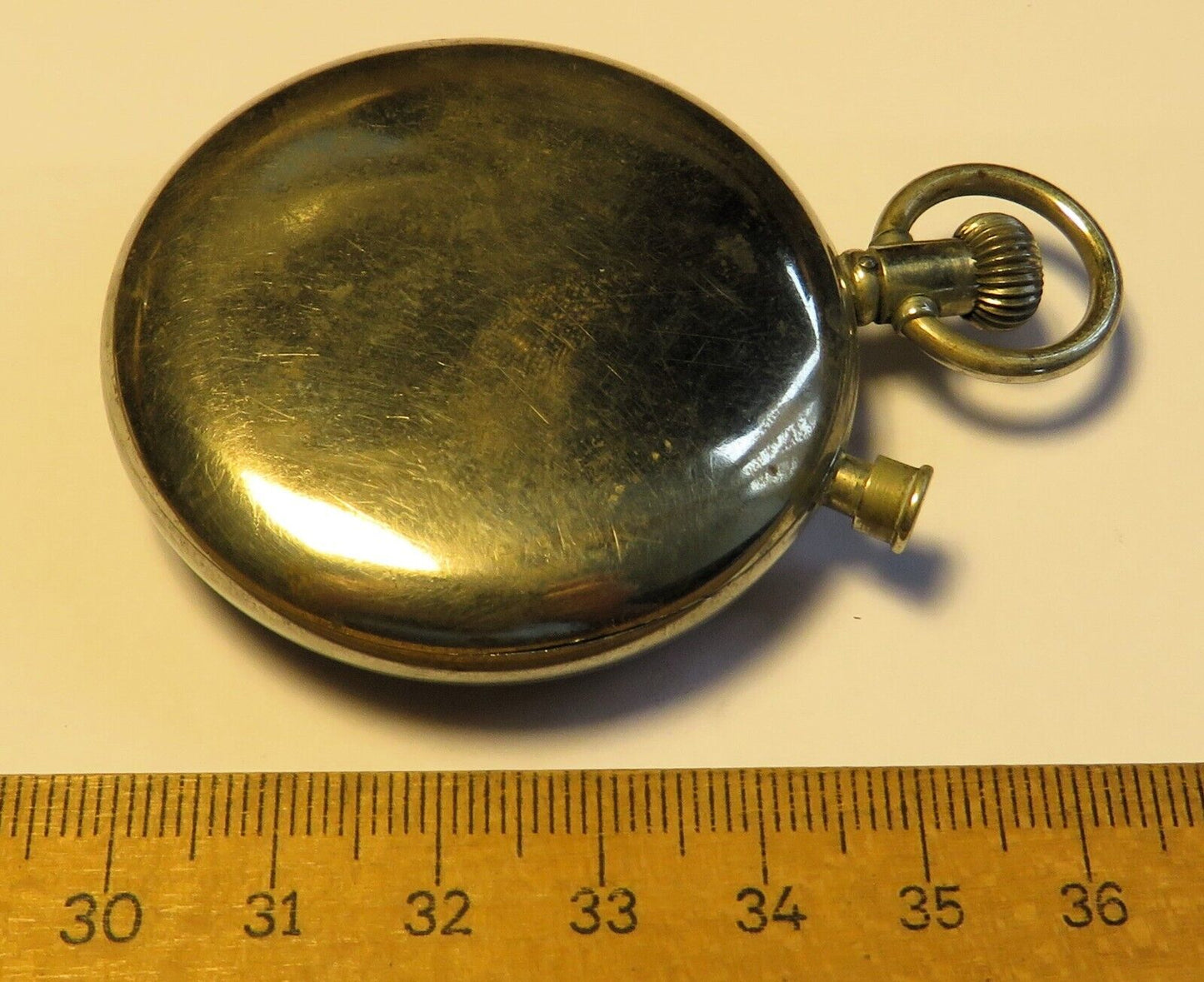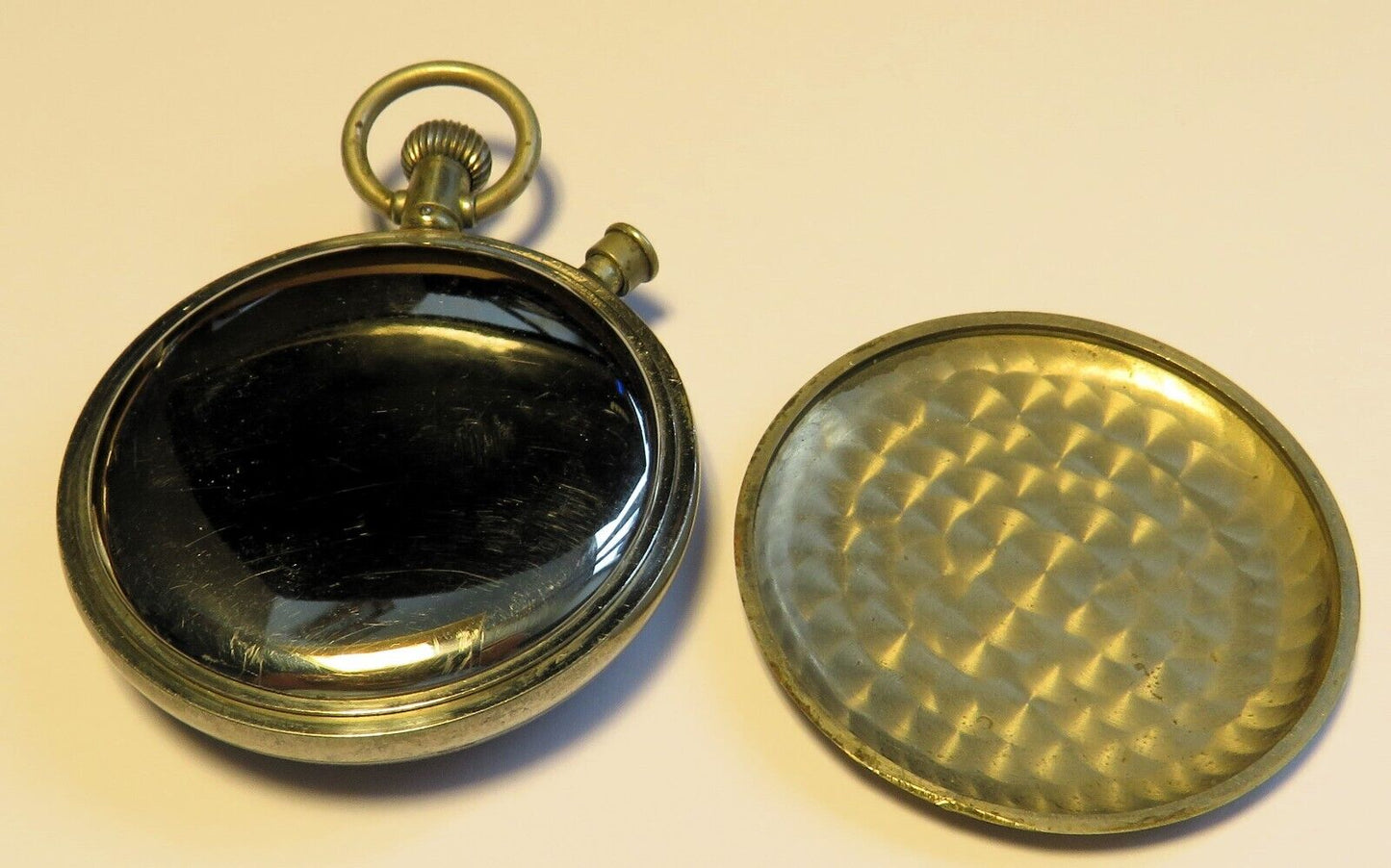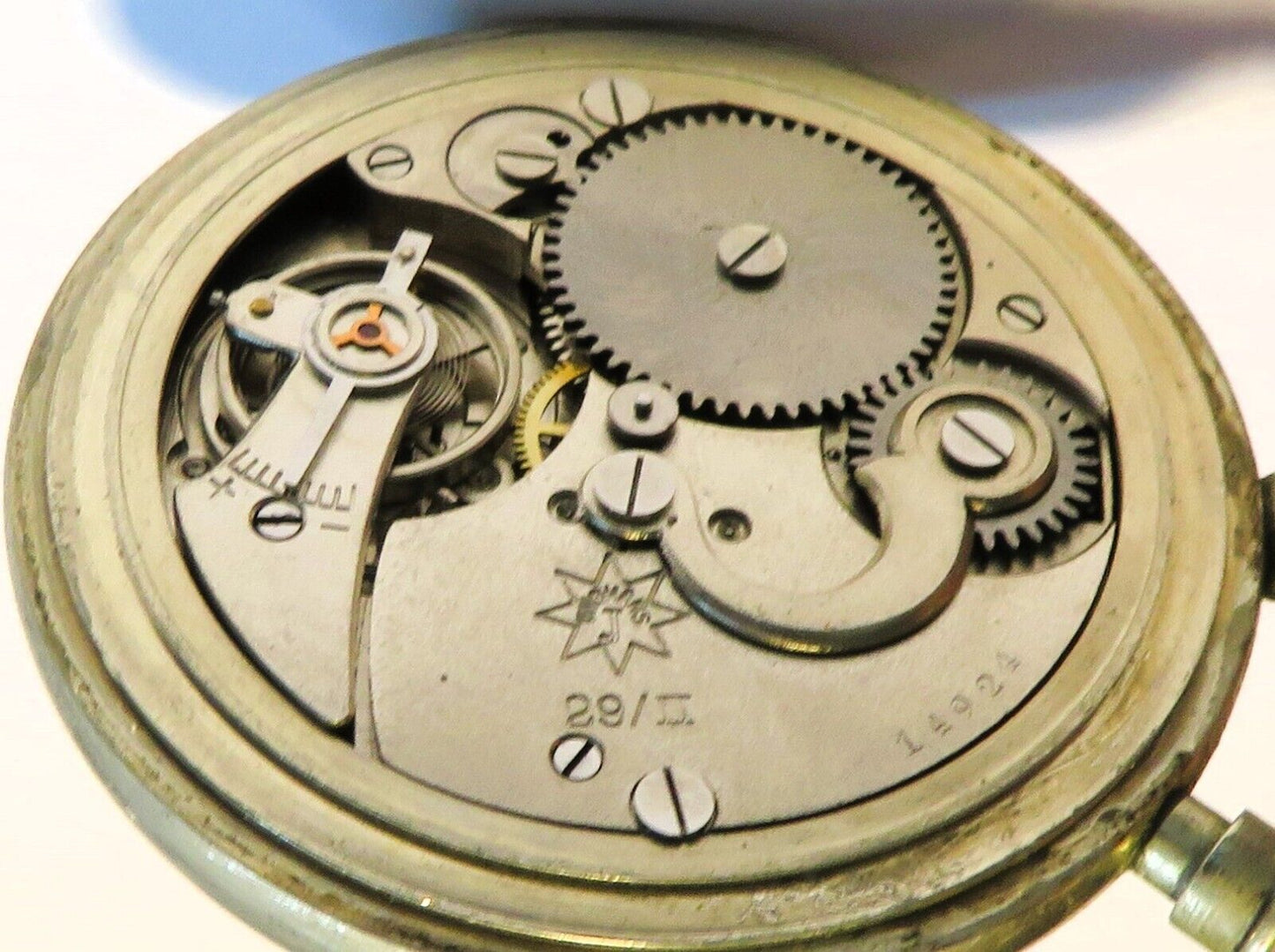Junghans
Rarest Caliber 29 II orig. Junghans Rattrapante Stopwatch World War II
Rarest Caliber 29 II orig. Junghans Rattrapante Stopwatch World War II
Couldn't load pickup availability
Subject of the auction:
Rare Junghans caliber rattrapante stopwatch WK 229 II, presumably a marine / torpedo running time stopwatch with typical top-mounted indirect second and onion crown as was common with the ship's clocks of the Kriegsmarine in the late 1930s, see Knirim p. 256ff
A rare piece of military and naval watch history that does not often come onto the market
Description:
The Junghans Torpedo running time stopwatch features the usual dimensions for the Navy: 47mm case diameter, white dial signed with full "Junghans" and "shock-protected" lettering, top-mounted indirect second, onion crown, pressed three-cover dial with inner movement protection cover, sparkling clean movement signed "Junghans 29 II"
The stopwatch and rattrapante functions are fully functional (accuracy not tested). Signed, immaculate movement, case and crystal show normal, visible signs of age or wear, and the unrestored dial is in good condition.
EZ 2: Good used collector's condition with age-appropriate signs of wear! Winds smoothly, runs and functions perfectly (accuracy not tested), unrestored dial in good condition, all lids close tightly and flush, crystal in good condition
In 1860, the merchant Erhard Junghans founded an oil mill in Schramberg with his brother-in-law Jakob Zeller-Tobler, but it was a financial failure. In 1861, Erhard Junghans founded the Gebrüder Junghans company in Schramberg with his brother Xaver Junghans, who had returned from the USA. Initially, they manufactured case parts for other watch manufacturers in the Black Forest. Starting in 1866/67, the first watch movements were manufactured. Daily production in 1870 was approximately 60 watches.
Erhard Junghans died in the autumn of 1870, after which his widow Luise Junghans took over the management of the company. On July 1, 1875, Luise Junghans sold the Junghans company to her sons Erhard the Younger and Arthur; according to the partnership agreement, the elder son Erhard (the Younger) took over both the commercial and technical management. In the years following the takeover, Arthur Junghans, who had previously worked for a year in American watch factories, initiated a series of technical modernizations. [1] At the end of the 1870s, Junghans also began producing alarm clocks based on the American model, which led to a significant expansion of the company. As early as 1883 and again in 1894, Arthur Junghans attempted to set up a production facility for simple pocket watches . However, a series of failures forced these efforts to be abandoned. Through the merger with the Schwenningen company Thomas Haller AG , which had been successfully manufacturing and marketing pocket watches since the mid-1890s, Junghans was able to expand its product range to include pocket watches from 1900 onwards. [2]
In 1888, the company introduced a five-pointed star with a "J" in the center as its trademark . In 1890, this star was given eight points and remains the company's trademark to this day. [3] By 1903, Junghans was the world's largest watch manufacturer, with more than 3,000 employees and a production of over three million watches per year. In 1906, Junghans also began producing ammunition detonators, which were produced in large quantities in Schramberg during the First World War.
In 1928, Junghans began producing wristwatches , initially using movements purchased from Gebrüder Thiel GmbH in Ruhla . From 1930, Junghans manufactured its own movements. At the same time, Junghans began collaborating with the French company ATO and producing the electric pendulum clocks of the same name until 1962. [4]
After the Nazis seized power , Junghans was reoriented toward armaments production by General Director Erwin Junghans (* 1875, † 1944, son of Arthur Junghans). Junghans applied for and received numerous armaments contracts (precision clocks for aircraft and ships, as well as all types of ammunition detonators) due to the war preparations. During the war years, over 9,000 employees worked in bomb-proof rooms in Schramberg, primarily manufacturing detonators and other armaments. Detonators developed by Junghans were also produced on a very large scale by other companies, particularly in Pforzheim, which led to the total destruction of Pforzheim by the Allies. Junghans also established branch factories for the production of armaments under neutral names in other cities (e.g., "MESSAP" in Hamburg). In Mühlheim an der Donau, Junghans maintained its own firing range for ammunition testing together with the Mühlheim watch factory.
In 1942, 440 " Eastern workers ", 332 prisoners of war and forced laborers from France, and 90 forced laborers from Poland were housed at Junghans in Schramberg. The French workers were mostly housed in communal accommodations or guesthouses, while the Soviet and Polish workers lived in barracks. [5] [6] After the end of the Second World War, the French military administration dismantled important machinery and sent it to France, but production of civilian watches could be resumed as early as 1946. Various company buildings were confiscated by the Allies as barracks for a while. Furthermore, Junghans was forced to deliver loose watch movements to France, which, however, were not sold in France but under the logo of French watch manufacturers abroad.
After the war, Junghans concentrated on producing high-quality wristwatches in order to regain its reputation with customers. As a result, Junghans became the largest manufacturer of chronometers [7] in Germany in the 1950s, for example with the Junghans Chronometer, launched in the early 1960s for around 160 DM with the J 85 caliber. [8] [9]
In 1956, the Junghans family lost the company and its management as part of a hostile takeover by Diehl in Nuremberg . The official takeover took place on November 15, 1956. The Diehl Group continued to operate the watch and detonator technology divisions separately. [10]
In 1972, Junghans provided the official timekeeping for the Summer Olympics in Munich .
Since 1984, two organizationally separate companies have existed: Uhrenfabrik Junghans GmbH & Co. KG and Junghans Microtec GmbH.
In 1986, Junghans presented a radio-controlled table clock, one of the world's first commercial radio-controlled clocks . [11] In 1990, the digital MEGA 1 , the world's first radio-controlled wristwatch, followed, and in 1991, the analog version , the Junghans Mega , was launched. The design was created by frog design . In 1995, Junghans presented a combination of a radio-controlled wristwatch with a solar power system and a ceramic case, the MEGA Solar Ceramic .
The Diehl Group sold its watch division to the holding company Egana Goldpfeil in 2000; the defense technology division and the company buildings in Schramberg remained with Diehl. At that time, the watch division employed approximately 220 people, and the defense technology division 350.
In 2004, Junghans presented the first multi-frequency radio-controlled wristwatch that receives signals from the time signal transmitters DCF77 in Europe, JJY in Japan and WWVB in the USA.
As a tribute to the company founder, the “Erhard Junghans” brand was introduced in 2006.
Junghans Uhren GmbH filed for insolvency on August 29, 2008, after its parent company , Egana Goldpfeil, had recently run into financial difficulties. [12] At that time, the company employed 115 people. On January 22, 2009, the insolvency administrator announced that a buyer for Junghans Uhren GmbH had been found. The Schramberg entrepreneur Hans-Jochem Steim, together with his son Hannes Steim, took over the business operations and all divisions of the company on February 1, which has been trading under the name Uhrenfabrik Junghans GmbH & Co. KG since February 1, 2009. [13] In the year of the takeover, Uhrenfabrik Junghans GmbH & Co. KG already achieved double-digit percentage growth in sales.
In 2011, Junghans celebrated its 150th anniversary with limited edition models and reinterpretations of historical series.
The historically significant and listed terraced building, designed and built in 1917/1918 by the German architect Philipp Jakob Manz , was restored under the supervision of the Monument Protection Authority and opened to the public as a museum in June 2018. The Junghans Terraced Building Museum focuses on Black Forest clocks, clocks with musical instruments, and the history of the clock factory.
In July 2018, Junghans presented the new radio-controlled clock movement J101, which for the first time enables a classic watch design for a radio-controlled clock.
An offer from the sole proprietorship Reiner Haas, Managing Director is Reiner Haas
Our company is taxed according to the differential taxation method, no VAT is shown in the final price
Cancellation policy
Right of withdrawal
You have the right to withdraw from this contract within fourteen days without giving any reason.
The cancellation period shall expire after fourteen days from the day on which you, or a third party other than the carrier designated by you, takes possession of the goods. To exercise your right of cancellation, you must notify us of your decision to cancel this contract by means of an unambiguous declaration (e.g., a letter sent by post, fax, or email). You may use the sample cancellation form below, but this is not mandatory.
The revocation must be addressed to:
Reiner Haas sole proprietorship
Rennmühle 3A, 91126 Schwabach
To comply with the cancellation period, it is sufficient that you send the notification of the exercise of the right of cancellation before the expiry of the cancellation period.
Consequences of revocation
If you cancel this contract, we will refund all payments that we have received from you, including delivery costs (with the exception of additional costs resulting from your choice of a delivery method other than the cheapest standard delivery offered by us), immediately and at the latest within fourteen days from the day on which we received notification of your cancellation of this contract.
For this refund, we will use the same means of payment that you used for the original transaction, unless something else was expressly agreed with you; under no circumstances will you be charged any fees for this refund.
We may refuse repayment until we have received the goods back or until you have provided evidence that you have returned the goods, whichever is the earlier.
whichever is earlier.
You must return or hand over the goods to us immediately and in any event no later than fourteen days from the date on which you notify us of the cancellation of this contract.
The deadline is met if you send the goods before the expiry of the fourteen-day period. You will bear the direct cost of returning the goods.
You only have to pay for any loss of value of the goods if this loss of value is due to handling of the goods which is not necessary to check their quality, properties and functioning.
If you wish to withdraw from the contract, please fill out this text template and send it back to:
Reiner Haas sole proprietorship
Rennmühle 3A
91126 Schwabach
I/we hereby revoke the contract concluded by me/us for the purchase of the following goods:
…............................................................................................................…................................................................................................................................................................................................................
Ordered on …......................................................
Received on …..................................................
Name of the consumer(s)
…........................................................................................
Address of the consumer(s)
…........................................................................................................….................................................................................................…..........................................................................................................…...........................................................................................................................................
Date and signature of the consumer(s) (only if notification is made on paper)
.........................................................................................................
EU Commission platform for online dispute resolution: https://www.ec.europa.eu/consumers/odr
